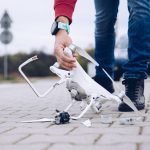Just got your first drone? Welcome to the sky! Flying drones is exciting, but it also comes with responsibility. Before you take off, it’s important to understand the basics of safe, legal, and skillful drone operation. Here are essential tips every new drone pilot should know to make your flights smooth and enjoyable.
1. Understand the Rules and Regulations
- Register your drone if required in your country
- Stay below 400 feet (120 meters) in altitude
- Never fly near airports, crowded areas, or restricted zones
- Keep your drone within line of sight at all times
2. Practice in Open Spaces
- Choose wide, obstacle-free areas like parks or fields
- Avoid flying near people, power lines, or water until you’re confident
- Start slow and focus on basic movements before advanced maneuvers
3. Check the Weather Before Flying
- Windy or rainy conditions can make flying difficult and dangerous
- Ideal flying conditions are clear skies with light winds
- Use apps or weather sites to track wind speeds and forecasts
4. Calibrate Before Each Flight
- Calibrate your drone’s compass and IMU regularly
- Make sure GPS signals are strong before takeoff
- Do a quick pre-flight inspection of props, battery, and sensors
5. Use Beginner Flight Modes
- Most drones offer beginner or “cinematic” modes to slow movement
- Practice takeoffs, landings, and hovering before advancing
- Use these modes to build confidence and reduce crash risk
6. Learn Battery Management
- Don’t let your battery drop below 20% mid-flight
- Keep an eye on flight time and set return-to-home settings
- Always carry extra batteries for longer flying sessions
7. Respect Privacy and Local Laws
- Avoid flying over private property or capturing people without consent
- Some areas may have local drone bans or permit requirements
- Stay updated with FAA (or your national agency) rules
8. Master Smooth Controls
- Use gentle, gradual stick movements for better footage
- Practice coordinated turns, altitude adjustments, and hovering
- Learn to fly using both line-of-sight and first-person view (FPV)
9. Plan Your Flights Ahead
- Know your flight path, launch point, and emergency landing zones
- Use drone apps like AirMap or B4UFLY for real-time airspace info
- Charge all devices and prep your gear before heading out
10. Stay Updated and Keep Learning
- Join drone forums or local flying groups
- Watch tutorials and follow experienced pilots online
- Keep your firmware and flight software updated regularly
Conclusion
Flying drones is both a hobby and a skill that takes time to master. With safety, practice, and knowledge, you can avoid crashes, stay compliant with regulations, and capture amazing views from above. Start small, fly smart, and enjoy the journey into the world of aerial exploration.


